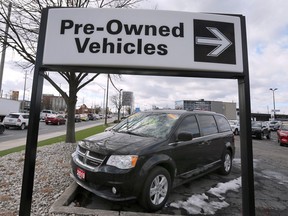
There are many uncertainties about how United States President Donald Trump’s tariffs will affect the auto industry, but sector insiders say one thing is all but certain: the price to buy a vehicle is about to go up and may already be rising.
“The first economic effect we’ll see, and it’s a major one, is on car prices,” Charles Bernard, lead economist at the Canadian Automobile Dealers Association, said. “And our car prices aren’t necessarily cheap right now at the moment, so it won’t help something that was already a problem.”
It all comes as a gut punch to some who believed the auto industry was just returning to a healthy state.
The auto sector had been hit hard by inflation, with the average price of a new car in Canada rising 43.2 per cent between 2019 and 2025, and used car prices rose 39.5 per cent during the same timeframe, according to data from AutoTrader.com Inc., the vehicle marketplace. But in 2024, the average used car price declined by 12.1 per cent.
Exactly how much car prices could rise again thanks to the latest tariffs is difficult to predict. J.D. Power earlier this month estimated that 25 per cent U.S. tariffs and counter-tariffs could add $6,000 to the price of a new vehicle, which is a 9.2 per cent increase given that the average new vehicle in Canada costs $64,600, according to Autotrader.
But nearly everyone agrees that estimate is only a rough guess and there are many factors at play.
Just two months into office, the Trump administration has unleashed a barrage of tariffs, threatened tariffs and reprieves that even economists are having a hard time keeping track of, let alone making sense of their combined impacts on the auto sector.
At the beginning of March, the U.S. enacted 25 per cent tariffs on all Canadian goods that are not compliant with the Canada-United-States-Mexico Agreement (CUSMA), which could affect some auto parts manufactured here, though most vehicles are believed to be compliant. It also levied 25 per cent tariffs on Canadian steel and aluminum, both of which are large inputs for vehicles.
Trump has further signalled that he plans to enact 25 per cent tariffs on April 2 on autos and additional 25 per cent “reciprocal“ tariffs on a sweeping set of goods, which would in effect match any costs that U.S. exporters face, such as goods and services taxes, that are not generally considered as trade duties.
Analysts at S&P Global Mobility are predicting a 50 per cent probability of there being “an extended disruption” — one that lasts 16 weeks to 20 weeks — when vehicles that are more exposed to tariffs will slow or cease production.
“Consumers will face rising costs on all goods, reducing available funds and willingness and ability for purchasing durable goods,” Stephanie Brinley, associate director of autoIntelligence at S&P, said in a note on March 12. “We expect product development delays to have lasting effects into future years.”
She said one “more dire scenario,” in which tariffs on vehicles produced in Canada and Mexico are integrated into the long-term trade structure on a permanent basis, has a 20 per cent probability of happening. Although this could increase U.S. manufacturing, she said it would increase costs and likely lead to a decline in vehicle sales.
Brinley gives a 30 per cent probability for a “quick resolution” and tariffs disappearing in a month or less, but this would still lead to lower production due to supply chain issues and border gridlock.
Eventually, many economists say the tariffs could lead to inflation or a recession, which will affect interest rates and consumer behaviour, including whether to purchase a vehicle.
“With these tariffs in place, we would expect to see vehicle sales in these countries contract substantially,” Andrew Foran, an economist at TD Economics, said in a Jan. 28 note.
Even 10 per cent tariffs could lead to a sales decline of light vehicles in Canada of around eight per cent, while a 25 per cent tariff could push the decline to around 13 per cent, he said.
Since tariffs raise prices for consumers and businesses, people will have less money to spend and economic growth will weaken, Foran said. That leads to higher unemployment and stagflation, which is weak growth and high inflation combined.
“We were so close to normalcy,” Baris Akyurek, vice-president of insights and intelligence at AutoTrader, said. “Everything was coming down, the demand was there, the supply was there, we were really close to normalcy and then this stuff happened.”
He said used car prices are an important indicator because it’s the marketplace that absorbs demand when new car prices rise.
Typically, he said, used car prices start the year high and then decline, but used car prices have risen 0.4 per cent so far in March.
“It’s not by much yet, and it’s only 16 days of data, so this is not conclusive, but prices had been coming down,” Akyurek said.
On the other hand, the average price of a new vehicle declined by 0.2 per cent.
But he said there are other troubling signs in the marketplace. Sellers have stopped dropping their prices as often this year, with a 22 per cent year-over-year decline in the number of price drops amongst all vehicles listed on AutoTrader.
Some dealerships in Canada are building up inventory now, which will provide a cushion against price increases for a period of time since those vehicles will not be affected by tariffs if they are imported before they go into effect.
“It’s pretty clear what’s going on,” said Akyruek, who added that rises in price at this point “are inevitable.”
Auto prices already rising as tariffs loom | financial post. (n.d.). https://financialpost.com/transportation/autos/auto-prices-already-rising-tariffs-loom










